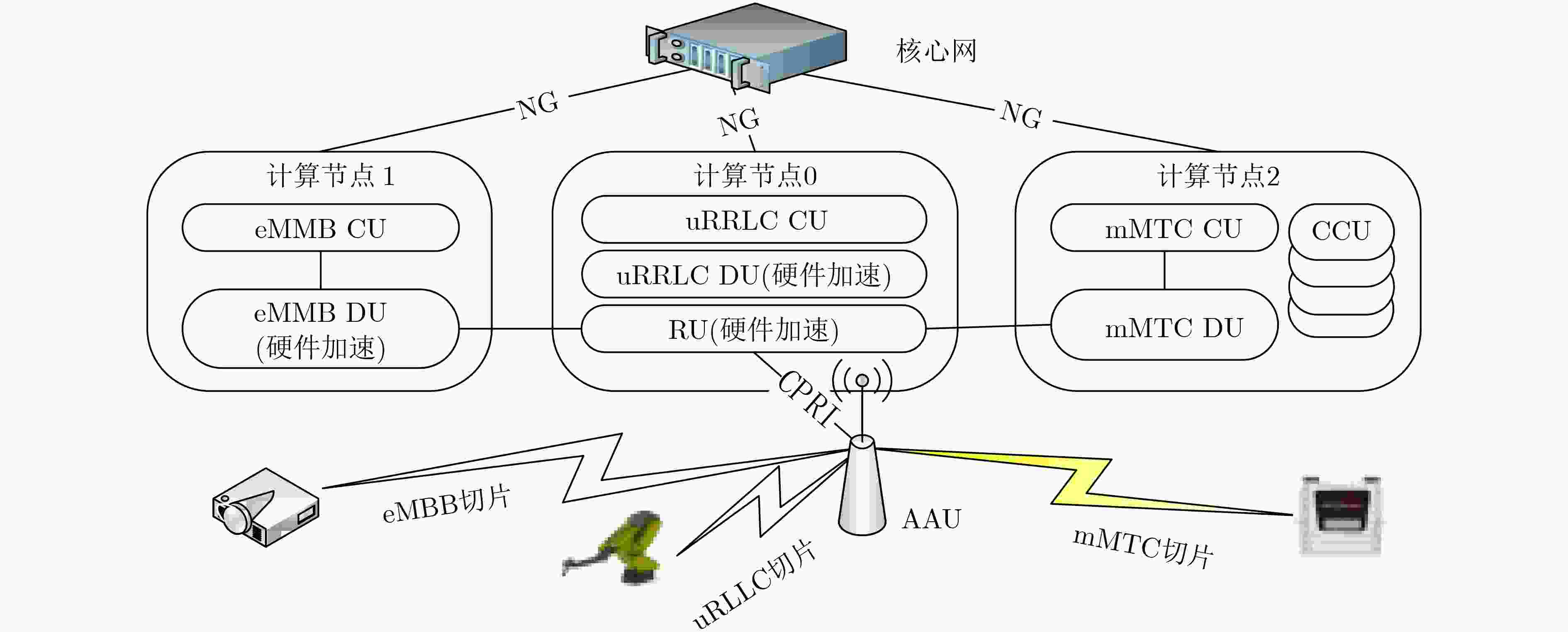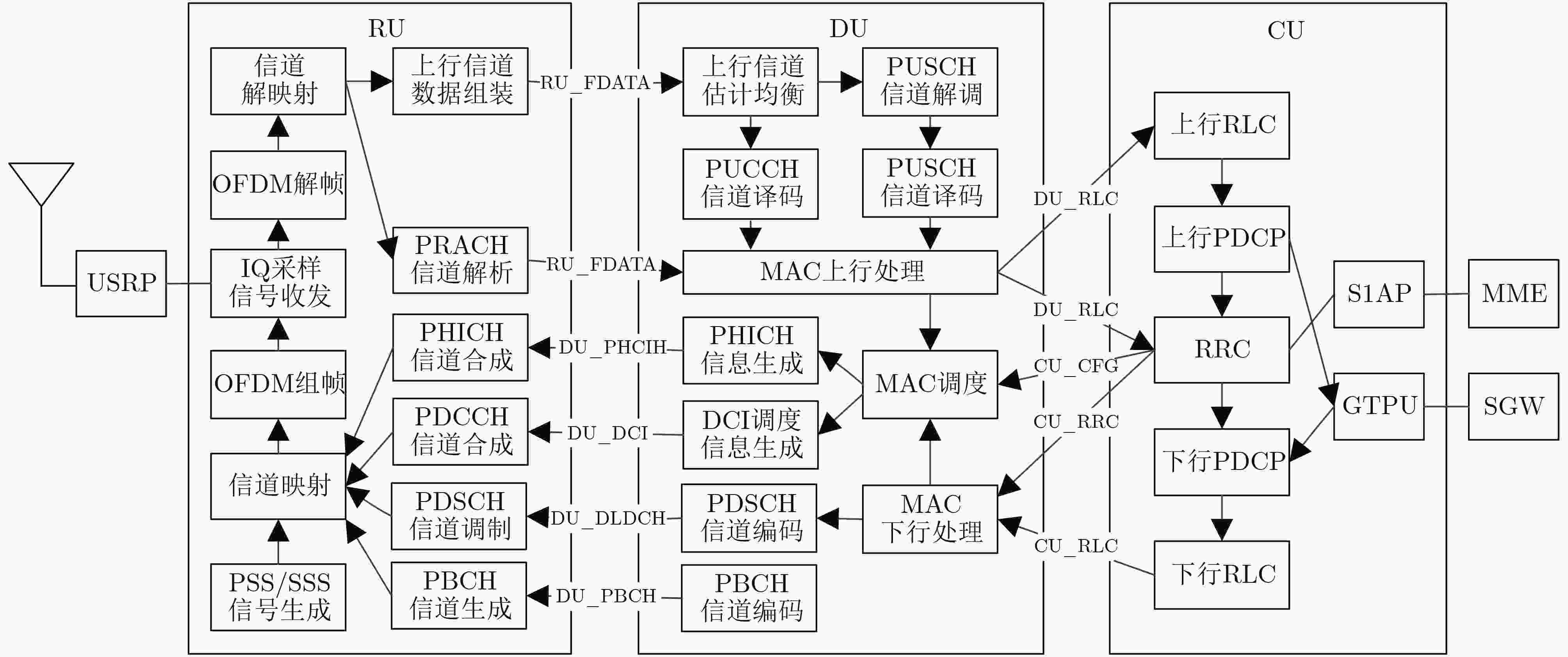Research on Componentization of Software Defined Wireless Access Network
-
摘要: 针对5G通信技术高传输速率、多业务场景的挑战,该文提出一种组件化的软件定义无线接入网络新架构。该架构在5G接入网集中单元(CU),分布单元(DU),有源天线单元(AAU)架构的基础上,进一步朝组件化方向演进,形成一种由集中控制单元(CCU), CU, DU,射频单元(RU),AAU等组件化通信单元组成的新架构。这种新架构既有利于切片化、虚拟化实现无线接入网,又有利于应用分布式计算技术和硬件加速技术突破通用处理器的计算能力瓶颈,还能降低DU与AAU之间的前传压力。该文还研制了基于此架构的组件化软基站试验原型并进行了测试,结果表明该组件化方案在提供高度灵活性的同时,还能够提升通用处理器软基站的吞吐能力,并有效降低远端站址传输流量。Abstract: In view of the challenges of 5G communication technology with high speed and multiple service scenarios, this paper proposes a new component-based Software Defined wireless access Network (SDN) architecture. Based on the architecture of Centralized Unit (CU), Distributed Unit (DU) and Active Antenna Unit(AAU) in 5G access network, further component-based evolution is carried out to form a new architecture composed the communication units of Centralized Control Unit (CCU), CU, DU, Radio Unit(RU), and AAU. This new architecture is not only conducive to the realization of wireless access network with slicing and virtualization, but also conducive to the adoption of distributed computing technology and hardware accelerating technology to break through the processing bottleneck of general-purpose processor, and reduce the forward transmission pressure between DU and AAU. In this paper, a prototype of component-based soft base station is developed and tested. The results show that the component-based scheme can not only provide high flexibility, but also improve the processing capacity of the general processor soft base station and reduce effectively the traffic of remote stations.
-
Key words:
- Software Defined Network(SDN) /
- Wireless access network /
- Componentization
-
表 1 拆分方案流量分析,以LTE单天线、正常循环前缀为例
选项 方向 5 MB 10 MB 20 MB Option8 上行、下行 245.76 Mbps 491.52 Mbps 983.04 Mbps Option7.1 上行、下行 134.40 Mbps 268.80 Mbps 537.60 Mbps Option7.1a 上行 各信道解映射后的流量之和,与业务量有关,最大值与Option7.1相等 Option7.2 上行 各信道估计之后、均衡之前的流量之和,包含信道估计信息,流量约为Option7.1a两倍 下行 与应用层数据量有关,满负荷时比Option7.1略小,不包括参考信号、下行同步信号 Option7.3 上行 各信道解调后、译码前的流量之和,流量比Option7.1a略小 下行 各信道调制前的流量之和,与应用层数据流量相当 表 2 组件化与非组件化对比测试结果
测试项目 组件化(CU+DU+RU) 非组件化 上行传输(5 Mbps) 时延抖动 0.09 ms 0.06 ms 内存消耗 22.7%(CU 4.2% DU14.3% RU 4.2%) 14.4% CPU占用率 50.9%(CU 3.0% DU28.6% RU19.3%) 38.3% 下行传输(10 Mbps) 时延抖动 0.38 ms 0.40 ms 内存消耗 22.8%(CU 4.3% DU14.3% RU 4.2%) 14.5% CPU占用率 40.0%(CU 3.7% DU15.0% RU21.3%) 26.6% 表 3 组件化C-RAN方案与CU-DU C-RAN方案比较(以10 Mbps下行传输为例)
传输情况 比较项目 组件化C-RAN方案 传统CU-DU C-RAN方案 优势倍数 理想传输条件 组网方案 CU, DU和RU都部署在中心机房 云资源池计算集中度 100% 1.00 站址传输流量 245.76 Mbps 1.00 非理想传输条件 组网方案 中心机房部署CU和DU远端站址部署RU 中心机房部署CU远端站址部署DU 云资源池计算集中度 49.48% 1.39% 35.60 站址传输流量 15.5 Mbps 11.5 Mbps 1.35 -
[1] I C L, HUANG Jinri, DUAN Ran, et al. Recent progress on C-RAN centralization and cloudification[J]. IEEE Access, 2014, 2: 1039. doi: 10.1109/ACCESS.2014.2351411 [2] 王晓云, 黄宇红, 崔春风, 等. C-RAN: 面向绿色的未来无线接入网演进[J]. 中国通信, 2010, 7(3): 107–112.WANG Xiaoyun, HUANG Yuhong, CUI Chunfeng, et al. C-RAN: Evolution toward green radio access network[J]. China Communications, 2010, 7(3): 107–112. [3] LIN Yonghua, SHAO Ling, ZHU Zhenbo, et al. Wireless network cloud: Architecture and system requirements[J]. IBM Journal of Research and Development, 2010, 54(1): 12. doi: 10.1147/JRD.2009.2037680 [4] 田霖, 翟国伟, 黄亮, 等. 基于集中式接入网架构的异构无线网络资源管理技术研究[J]. 电信科学, 2013, 29(6): 25–31. doi: 10.3969/j.issn.1000-0801.2013.06.004TIAN Lin, ZHAI Guowei, HUANG Liang, et al. Research on key technologies of heterogeneous wireless network resource management based on centralized radio access network architecture[J]. Telecommunications Science, 2013, 29(6): 25–31. doi: 10.3969/j.issn.1000-0801.2013.06.004 [5] EURECOM. OpenAirInterface[EB/OL]. http://www.openairinterface.org, 2019. [6] Software Radio Systems. SRSLTE[EB/OL]. https://www.softwareradiosystems.com/products/#srslte, 2019. [7] 咸立文, 姚幽然, 赵扬. 基于开源SDR的LTE系统对比研究与实现[J]. 通信技术, 2018, 51(6): 1307–1314. doi: 10.3969/j.issn.1002-0802.2018.06.013XIAN Liwen, YAO Youran, and ZHAO Yang. Comparative research and implementation of LTE system based on open-source SDR[J]. Communications Technology, 2018, 51(6): 1307–1314. doi: 10.3969/j.issn.1002-0802.2018.06.013 [8] WANG Jiang, XU Jing, YANG Yang, et al. GPP based open cellular network towards 5G[J]. China Communications, 2017, 14(6): 189–198. doi: 10.1109/CC.2017.7961374 [9] 张海波, 荆昆仑, 刘开健, 等. 车联网中一种基于软件定义网络与移动边缘计算的卸载策略[J]. 电子与信息学报, 2020, 42(3): 645–652. doi: 10.11999/JEIT190304ZHANG Haibo, JING Kunlun, LIU Kaijian, et al. An offloading mechanism based on software defined network and mobile edge computing in vehicular networks[J]. Journal of Electronics &Information Technology, 2020, 42(3): 645–652. doi: 10.11999/JEIT190304 [10] CHEN Shanzhi and KANG Shaoli. A tutorial on 5G and the progress in China[J]. Frontiers of Information Technology & Electronic Engineering, 2018, 19(3): 309–321. doi: 10.1631/FITEE.1800070 [11] CPRI. Common Public Radio Interface (CPRI) Specification (V6.0)[S]. CRPI, 2013. [12] 3GPP. TR 38.801 Study on new radio access technology: Radio access architecture and interfaces (Release 15)[S]. 3GPP, 2017. [13] Ericsson AB, Huawei Technologies Co. Ltd, NEC Corporation, et al. eCPRI transport network V1.2[EB/OL]http://www.cpri.info/downloads/Requirements_for_the_eCPRI_Transport_Network_V1_2_2018_06_25.pdf, 2018. [14] China Mobile Research Institute. White paper of next generation fronthaul interface[EB/OL]. labs. chinamobile. com/cran, 2015. [15] I C L, LI Han, KORHONEN J, et al. RAN revolution with NGFI (xhaul) for 5G[J]. Journal of Lightwave Technology, 2018, 36(2): 541–550. doi: 10.1109/JLT.2017.2764924 [16] I C L, HUANG Jinri, YUAN Yannan, et al. 5G RAN architecture: C-RAN with NGFI[M]. XIANG Wei, ZHENG Kan, and SHEN Xuemin. 5G Mobile Communications. Cham: Springer, 2017: 431–455. doi: 10.1007/978-3-319-34208-5_16. [17] 唐伦, 魏延南, 马润琳, 等. 虚拟化云无线接入网络下基于在线学习的网络切片虚拟资源分配算法[J]. 电子与信息学报, 2019, 41(7): 1533–1539. doi: 10.11999/JEIT180771TANG Lun, WEI Yannan, MA Runlin, et al. Online learning-based virtual resource allocation for network slicing in virtualized cloud radio access network[J]. Journal of Electronics &Information Technology, 2019, 41(7): 1533–1539. doi: 10.11999/JEIT180771 [18] NIU Binglai, ZHOU Yong, SHAH-MANSOURI H, et al. A dynamic resource sharing mechanism for cloud radio access networks[J]. IEEE Transactions on Wireless Communications, 2016, 15(12): 8325–8338. doi: 10.1109/TWC.2016.2613896 [19] KALIL M, Al-DWEIK A, SHARKH M F A, et al. A framework for joint wireless network virtualization and cloud radio access networks for next generation wireless networks[J]. IEEE Access, 2017, 5: 20814–20827. doi: 10.1109/ACCESS.2017.2746666 [20] 3GPP. TS 23.501 System architecture for the 5G system (Release 15)[S]. 3GPP, 2017. [21] 施南翔, 宋月, 刘景磊, 等. 5G核心网标准化进展及B5G演进初探[J]. 移动通信, 2020, 44(1): 2–7. doi: 10.3969/j.issn.1006-1010.2020.01.001SHI Nanxiang, SONG Yue, LIU Jinglei, et al. Standardization progress of 5G core networks and research on beyond 5G evolution[J]. Mobile Communications, 2020, 44(1): 2–7. doi: 10.3969/j.issn.1006-1010.2020.01.001 [22] 3GPP. TS 38.300 NR and NG-RAN overall description, stage 2 (Release 15)[S]. 3GPP, 2018. [23] 魏垚, 谢沛荣. 网络切片标准分析与发展现状[J]. 移动通信, 2019, 43(4): 25–30. doi: 10.3969/j.issn.1006-1010.2019.04.005WEI Yao and XIE Peirong. Network slicing standard analysis and development status[J]. Mobile Communications, 2019, 43(4): 25–30. doi: 10.3969/j.issn.1006-1010.2019.04.005 [24] 刘珊, 韩潇, 黄蓉. 面向5G的无线侧网络切片发展与研究[J]. 邮电设计技术, 2020(1): 45–49.LIU Shan, HAN Xiao, and HUANG Rong. Development and research of network slice for 5G RAN[J]. Designing Technioues of Posts and Telecommunications, 2020(1): 45–49. [25] BAHL L, COCKE J, JELINEK F, et al. Optimal decoding of linear codes for minimizing symbol error rate (Corresp.)[J]. IEEE Transactions on Information Theory, 1974, 20(2): 284–287. [26] FOSSORIER M P C, MIHALJEVIC M, and IMAI H. Reduced complexity iterative decoding of low-density parity check codes based on belief propagation[J]. IEEE Transactions on Communications, 1999, 47(5): 673–680. doi: 10.1109/26.768759 -






 下载:
下载:






 下载:
下载:
